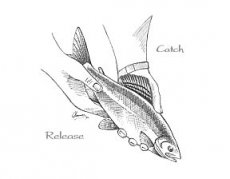Basic information on the application of the Catch and Release method in fishing.
"Catch and release" is a phrase that is often used as the name of games where players try to catch an object as quickly as possible and then throw it away as quickly as possible. These games are often played with young children and aim to develop their fine motor skills and coordination of movements.
In fishing, "catch and release" refers to a fishing philosophy where the angler catches the fish but then releases it back into the water without (ideally) putting it in the landing net at all. This approach to fishing is often considered more sustainable and environmentally friendly, as it allows the fish to survive and reproduce, which is important for the maintenance of fish stocks in the area. In addition, catch and release of fish can also be regulated by local rules, which may include restrictions on the size and number of fish that can be caught.
To effectively apply the catch-and-release philosophy when fishing, we recommend following these steps:
- Respect the laws and rules: Before you start fishing, familiarize yourself with local laws and rules that regulate how many and what kind of fish you can catch and release. These rules are crucial for the sustainability of the fishery and for protecting fish stocks.
- Use gentle tackle: Use tackle that minimizes damage to fish, such as barbless hooks and lead-free hooks. It is also advisable to use feed that attracts fish but does not harm them.
- Release the fish quickly: When you catch a fish, release it back into the water as quickly as possible so it can recover quickly and have plenty of oxygen. It is also advisable to handle the fish minimally and not hold it longer than absolutely necessary.
- Use the correct tools: For releasing fish, it is best to use special tools such as rubber-netted landing nets, fishing flats or rubber pads that allow the fish to be released safely and gently.
- Take care of your health: fishing can be dangerous, so take care of your health and safety. Wear protective gear, such as gloves, and avoid contact with poisonous fish.
By following these steps, you can be sure that you are taking a sustainable and environmentally friendly approach to fishing.















